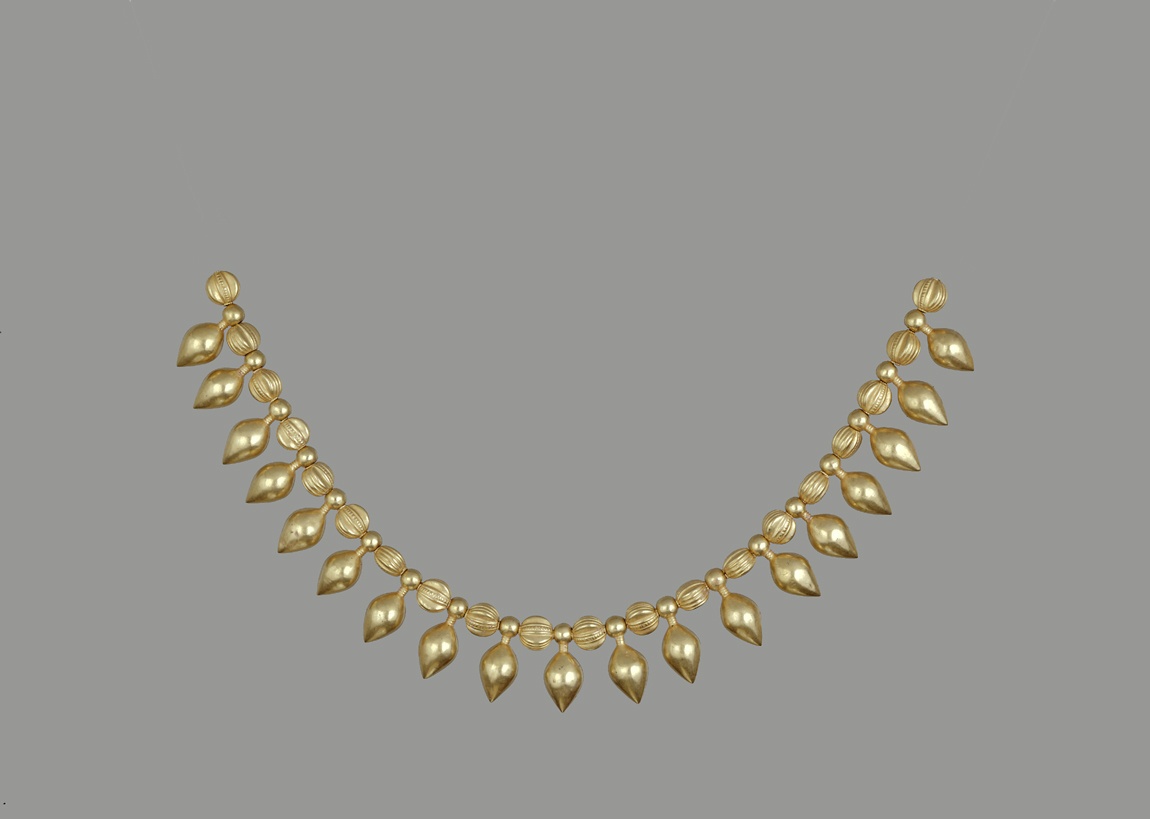
Gold
Necklace: Weight: 51 g. L: 27.7 cm
Clasps: Weight: 21 g; 20.50 g. L: 4.07 cm; 4.1 cm
Allegedly from Asia Minor
Ionian Art
Second-third quarter of the 6th century B.C.
The drops [1] and interspaced beads made of gold sheet - shaped, cold-worked and polished.
The hair "clasps" made of gold sheet, each spool-shaped element made separately, annealed, hammered and polished. The two elements joined by a section of hammered gold plate cut to shape and embellished with filigree work: S-shaped loops, gold beads and the rosettes they nest in, two tear drops, all made separately and soldered on - gold to gold.
Condition: almost as when made, the surface very slightly scratched and worn.
The necklace consists of nineteen drops and twenty beads, probably derived from vegetable forms. The drops originally possibly acorns [2] evolved into a stylized vase-shape, e.g.
the necklace on the Kore in Berlin [3] allegedly from Keratea in Attica. The earliest jewellery prototypes surely originated in
the Near East.
The hair "clasps" derived from astragals are comparable to simpler examples in ivory and bone from Ephesos. There is a pair in gold in Berlin [4] said to be from the grave of a Lydian maiden, but they are plain and without any filigree decoration on the flat section that joins the spools. They are alleged to be from Ephesos and found with pottery datable to the first half of the 6th century. Reputably from the same find an electrum fibula in the form of a hawk is an added indication for Ephesos.
For their function, they have even been thought to be ear studs [5]. However, in view of their size we doubt that East Greek korai, for that matter Greek korai anywhere, would have had holes in their ear lobes [6] sufficient to accommodate them.
We think that their most probable use was as hair "clasps" though they could have been strung so as to hang from the ear lobes.
Exhibited and Published:
L'Or et son Mythe, cat. no. 623, pp. 232, 156 col. ill.
See: Spier, J.: Minor Arts and Regional Styles in East Greece, 700-500 B.C. (Diss. Oxford Univ. 1987), pp. 327-328, fig. 320.
1 These made in three parts: the body, neck and head annealed together.
2 See e.g. those found in a grave dated 550 B.C. at Gordion: Young, R.S.: Gordion - 1950, University of Pennsylvania Museum Bulletin, vol. 6, no. 1, May 1951, pp. 17-19 fig. 3.
3 Staatliche Museen 1800: Richter, G.M.A.: Korai. Archaic Greek Maidens (London, 1968), no. 42, pp. 39-40, fig. 139-142.
4 Greifenhagen, A.: Schmuck und Gerät eines lydischen Mädchens, AntK 8, 1, 1965, p. 13 ff.
5 Brein, F.: Ear Studs for Ladies, AnatSt XXXII, 1982, p. 89 ff.
6 The Indians of South and Central America wore huge ear-rings through their lobes, but we are not aware of such practice in the Mediterranean world.